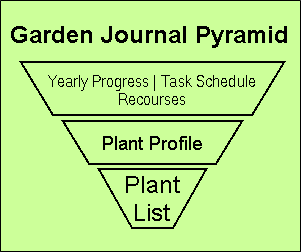|
Program
|
|
|
|
|
|
|
|
|
|
|
|
Clipping File Plant Registry Progress Journal Planning Model Perhaps the most satisfying type of garden journal is the dream book, filled with notes taken on garden tours, photos of public gardens, magazine pictures of plant combinations or ornamental features. This format serves as a source of inspiration and a beginning point for future plans. You may also simply need a place to jot down reminders – like, “move lily bulbs to back of border when foliage begins to die in fall.” Another type of planning journal may have graph-paper pages, for scale drawings of garden plans. Keepsake Scrapbook Photo album For those who aren’t much into writing, snapshots tell a story too. Looking back on spring’s photos from autumn’s perspective can remind you what needs to be moved or divided, or where there is a gap in your succession of bloom.
|
|
|
|
Bound Blank Page Notebook Bookstores often feature blank garden journals that feature artwork, quotes, or horticultural info. Some other suggestions for journal possibilities include: blank books, calendars, accordion files, a scrapbook, a photo album, a loose-leaf binder. Commercial Garden Journal File Drawer / Organizer / Box A journal with pockets or plastic sleeves can help you keep track of garden catalogs, receipts, order forms, helpful magazine articles, seed packets, notes that you scribbled on a scrap paper, etc. A pretty decoupage box can also be a good place to keep things together – no one says a journal has to be a book. Computer Files Website or software ( http://www.mygardenjournal.com)
|
|
|
 Suggestions Suggestions
Set a mission for your journal & PURSUE IT!! (Decide first what you’d like your journal to accomplish.) Find a format that fits your needs, style and time commitment (uses printed formats -- examples) Maintain a routine weekly work session (hardest thing to do) Simple with Potential Start simple with options to expand. Avoid being overwhelmed by doing to much in the Journal.
|
|
|
|
Getting Started |
|
Plant Profile
Yearly Progress Plant list for specific beds
(new plants, carry-over plants) General garden additions and
changes Task Schedule Organize my month or season List transplanting, dividing,
planting, pruning, spraying, fertilizing, etc. Recourses Garden Catalogs Books and magazines Internet Goggle Images Landscape Plants
(Oregon State University)
|
|
|
|
Other Ideas of things to Journal
|
|
|
|
Show & Tell
|
|
|





